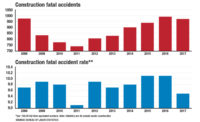Over all, there were almost 3 million workplace injuries and illnesses in 2012, down less than 1% from the 2011 level. The all-industry 2012 rate was 3.4 per 100 workers, compared with 3.5 in 2011, BLS said.
Chris Williams, Associated Builders and Contractors director of safety, said in e-mailed comments that the drop in construction's 2012 injury/illness rate "is encouraging and shows that our efforts to address jobsite hazards and eliminate them before they become incidents is bearing positive results." But Williams adds that "we still have work to do to achieve our goal of a zero-injury jobsite."
Pete Stafford, executive director of CPWR—The Center for Construction Research and Training, said in a statement, "While we're glad to see these [injury-illness] numbers, the numbers of severe (with days away from work) injuries and fatal injuries are on the rise."
Besides noting the increase in fatalities in 2012, Stafford observed that injuries leading to days away from work increased to 71,700 last year, from 71,600 in 2011. The center, formerly the Center to Protect Workers' Rights, was created by the AFL-CIO Building and Construction Trades Dept.
Brian Turmail, an Associated General Contractors of America spokesman, said in an interview, "I think we want to spend a good amount of time going through the [BLS] data to understand what it's telling us about what firms are doing right to improve safety and what firms still need to do."
Turmail added, "I think the question in everyone's mind is: why did the fatality rate...and the fatality numbers go up and injury rate go down—and how do you justify the two apparently contradicting trends?"
He says, "And it sounds like the Dept. of Labor is asking the same questions with their proposals to change the way firms report their injury data."
In announcing the new proposed data-submission rule, OSHA chief David Michaels said the agency is seeking to improve worker safety and health through better tracking of injury and illness information.
He told reporters in a conference call, “We believe the approach we’ve proposed is an effective, inexpensive and non-prescriptive way to encourage employers to reduce hazards and therefore save workers’ lives and limbs.”




Post a comment to this article
Report Abusive Comment